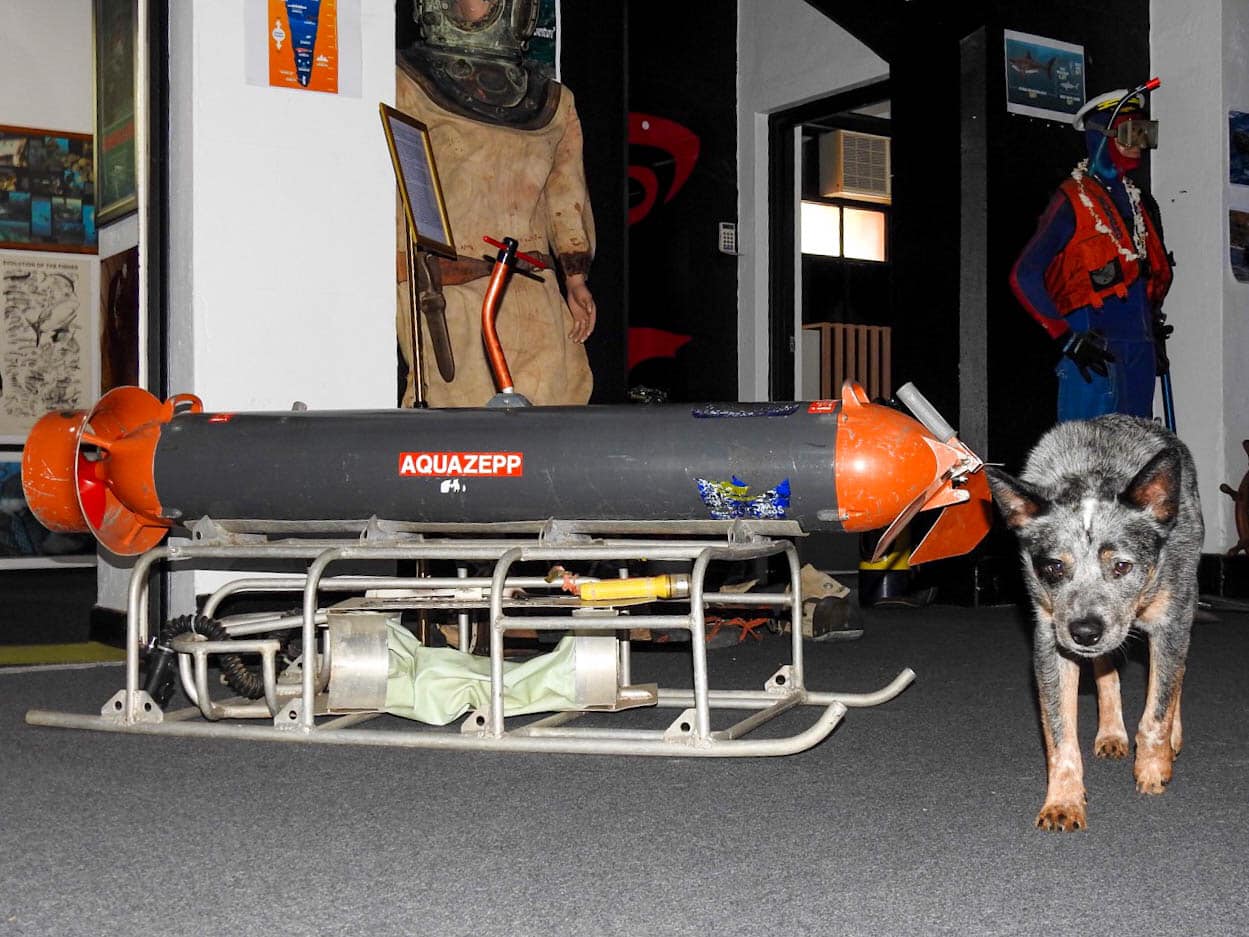
We have these amazing displays at the museum that come from the early cocklebiddy cave dives.
We have different items from the 80s and 90s including this amazing aquazepp scooter and sled.
In 1995: An Australian team headed by Chris Brown made an attempt to extend the known length of Cocklebiddy Cave. Team members included Dennis Thamm and Stefan Eberhard, both members of the 1983 expedition, David Doolette, Peter Girdler, Richard McDonald, Tim Payne, Wolf Seidal and Brenton Woolcock.
A Channel Nine documentary film crew accompanied the expedition. From previous experience gained from the 1988 Pannikin Plains expedition, the dive plan involved towing sleds with underwater scooters. With one Aquazepp scooter (as used by the French divers in 1983) and two Aquamacks (copies of the Aquazepps made by McDonald), three sleds were towed through the first sump to the Rock Pile accompanied by eight divers. Two sleds, three scooters and a large amount of gear was transported over the Rock Pile. Five divers continued in the second sump and traversed the 2,500 metres to Toad Hall towing the sleds in 1.5 hours, a full hour shorter than swimming a sled.
Base camp was set up in Toad Hall for a two day stay. The Aquazepp, eight tanks and a specially designed “no mount” sled were ferried across Toad Hall to the third sump.
The no mount sled consisted of an aluminium frame with two tanks strapped inside, two torches mounted at the front, and an inflatable buoyancy bag to make the sled neutrally buoyant and easy to push in front of the diver.
The idea of the no mount sled was to negotiate tight restrictions at the end of the cave without the burden of back mounted tanks. After assembling the equipment, Brown with three back mounted, one side mounted and four dive cylinders attached to the Aquazep, took a solo dive into the third sump. At the 1,200 metre mark from Toad Hall, the cave became too low to safely negotiate whilst riding the Aquazepp.
The scooter was parked on the floor of the cave and Brown removed the no mount with the 2 tanks inside and continued into the cave whilst breathing off his back tanks.
At the 1,550 mark, the furthest point reached by the 1983 French team due to a tight restriction and the point where Hugh Morrison left his buddies and continued on alone with a single tank, Brown removed his three back mounted tanks and continued on through the restriction with his no mount sled and a single side mounted tank.
After negotiating two tighter restrictions, he came across the abandoned line reel left by Morrison at the 1,790 metre mark, the furthest point of his penetration on the 1983 expedition. Brown tied one of his two line reels onto Morrisons line reel and continued on into the cave.
The tunnel was about 1 metre in diameter and continued on for 20 metres and then the roof slopped down and met the floor and the tunnel abruptly ended. With enough air and 300 metres of line on his two reels this was very frustrating to Brown.
He had reached 1,810 metres from Toad Hall and 6,260 metres from the cave entrance of which 5,310 metres was under water. He tied his line off on a rock on the cave floor and looked around.
The only continuing passage was on the left going down at a steep grade and was very low and tight about 400mm high and one to one and a half metres wide. Brown dropped his no mount sled, unfastened his side mount tank and continued down this passage for a short distance (approximately five metres) with the single tank. As the passage was not getting any larger he decided to concede and terminate the dive reeling back the five metres of line to the tie off rock.
188 minutes after leaving Toad Hall, Brown arrived back at the third sump lake and completed 60 minutes of decompression obligations before relaying his news to his waiting crew.
Reference cave diving down under

